|
|
Introduction.
Basic to the organization of the German motorization force was Panzer-Division.
It was, in theory, a balanced team of all arms - tank, infantry, artillery,
anti-tank and engineers - well blended together to produce the combination
of maximum striking power, high speed across country, and complete flexibility
in response to enemy action demanded by the rapid, independent thrusting
movements of panzer warfare. So the initial organization of "Versucus
Panzer-Division 1934/1935" (experimental Panzer-Division) distributed
within the Heeres on 12 Oct 1934 had already consisted of the components
listed above, although in a fair proportion. The experimental Panzer-Division
heritaged the traditional "Binary Formation" in Schnelle Truppen
during World War I. The Panzer-Division consisted one Panzer-Brigade of
two Panzer-Regiments, each with two battalions, one Schützen-Brigade
of one, 2 battalions, lorry-borne Schützen-Regiment, and one Kradschützen-Bataillon,
and one Artillerie-Regiment (mot) with two battalions as her major strike
forces. This made the ratio between tank and infantry to be 4 : 3 in the
battalion level, a little weaker in the infantry power. |
|



